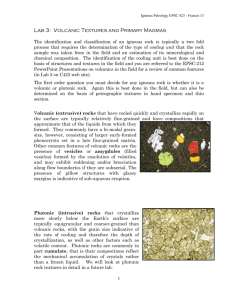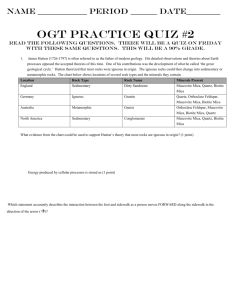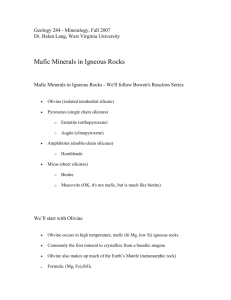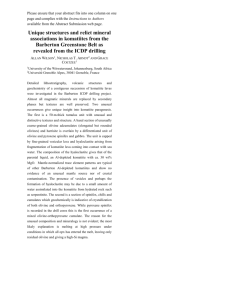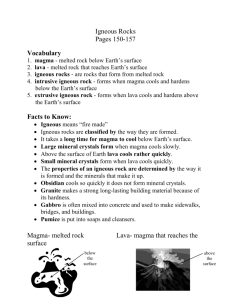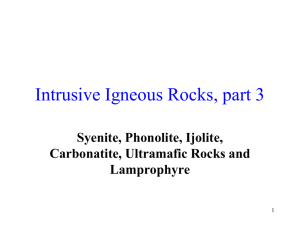Geol 101: Physical Geology
advertisement
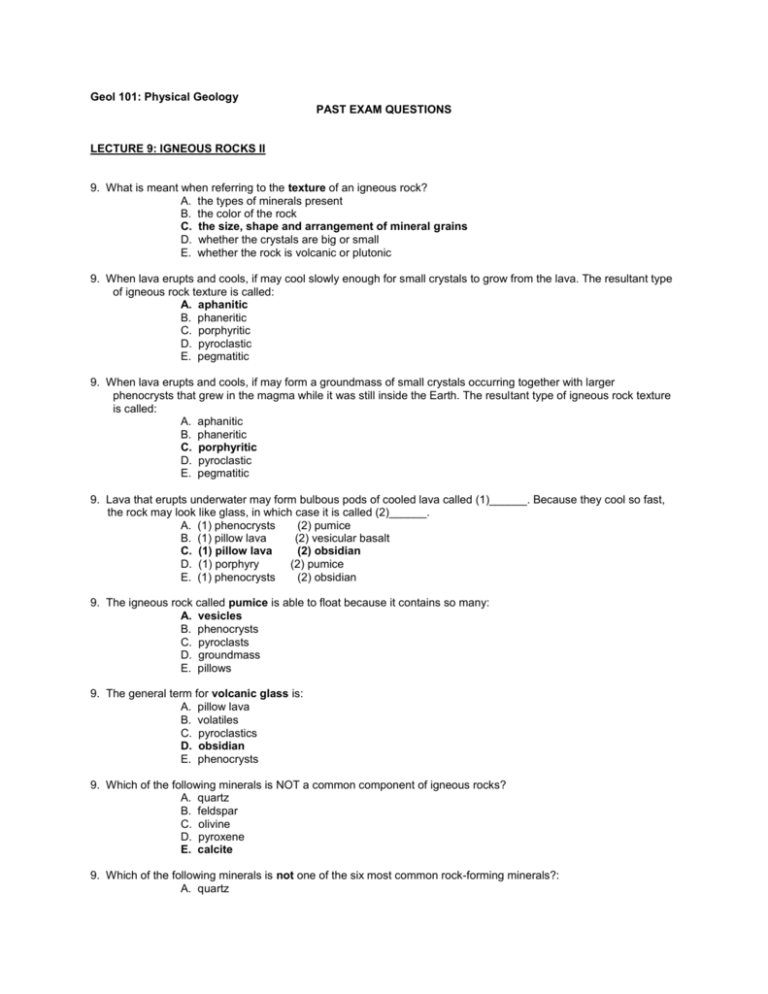
Geol 101: Physical Geology PAST EXAM QUESTIONS LECTURE 9: IGNEOUS ROCKS II 9. What is meant when referring to the texture of an igneous rock? A. the types of minerals present B. the color of the rock C. the size, shape and arrangement of mineral grains D. whether the crystals are big or small E. whether the rock is volcanic or plutonic 9. When lava erupts and cools, if may cool slowly enough for small crystals to grow from the lava. The resultant type of igneous rock texture is called: A. aphanitic B. phaneritic C. porphyritic D. pyroclastic E. pegmatitic 9. When lava erupts and cools, if may form a groundmass of small crystals occurring together with larger phenocrysts that grew in the magma while it was still inside the Earth. The resultant type of igneous rock texture is called: A. aphanitic B. phaneritic C. porphyritic D. pyroclastic E. pegmatitic 9. Lava that erupts underwater may form bulbous pods of cooled lava called (1)______. Because they cool so fast, the rock may look like glass, in which case it is called (2)______. A. (1) phenocrysts (2) pumice B. (1) pillow lava (2) vesicular basalt C. (1) pillow lava (2) obsidian D. (1) porphyry (2) pumice E. (1) phenocrysts (2) obsidian 9. The igneous rock called pumice is able to float because it contains so many: A. vesicles B. phenocrysts C. pyroclasts D. groundmass E. pillows 9. The general term for volcanic glass is: A. pillow lava B. volatiles C. pyroclastics D. obsidian E. phenocrysts 9. Which of the following minerals is NOT a common component of igneous rocks? A. quartz B. feldspar C. olivine D. pyroxene E. calcite 9. Which of the following minerals is not one of the six most common rock-forming minerals?: A. quartz B. C. D. E. feldspar pyroxene pyrite mica 9. In Bowen’s Reaction Series, the very first mineral to crystallize in the discontinuous branch is: A. quartz B. feldspar C. olivine D. pyroxene E. calcite 9. Which of the following statements about Bowens Reaction Series is false?: A. it tells us about the order in which minerals crystallize from molten rock B. the types of minerals that form depends on the chemistry of the magma C. different minerals crystallize at different temperatures as the magma cools D. quartz is the first mineral to crystallize in the series E. the discontinuous branch minerals are: olivine, pyroxene, amphibole, biotite 9. According to Bowens’ Reaction Series, the first mineral to crystallize out of mafic magma is: A. quartz B. muscovite mica C. olivine D. Ca-plagioclase E. either olivine or Ca-plagioclase 9. In Bowens’ Reaction Series, the only mineral listed below that does not belong in the discontinuous branch is: A. quartz B. biotite mica C. olivine D. pyroxene E. amphibole 9. Which of the following list of minerals is in the correct crystallization order according to Bowen’s Reaction Series (note that not all possible minerals in the series are shown)? A. Na-plagioclase, Ca-plagioclase, K-feldspar, quartz B. amphibole, Ca-plagioclase, K-feldspar, muscovite mica C. olivine, quartz, muscovite mica, amphibole D. olivine, pyroxene, amphibole, biotite mica E. quartz, muscovite mica, K-feldspar, Na-plagioclase 9. The type of feldspar that contains either Ca or Na is called: A. K-feldspar B. plagioclase C. calcite D. olivine E. granite 9. Which of the following lists of igneous rocks contain rock types that belong together in the same group? A. basalt; andesite; rhyolite B. basalt; gabbro; diorite C. gabbro; diorite; dacite D. granite; diorite; basalt E. granite; andesite; rhyolite 9. The volcanic rock (1)______ has a corresponding plutonic rock (2)______ having the same chemistry: A. (1) basalt (2) gabbro B. (1) andesite (2) granite C. (1) granite (2) diorite D. (1) rhyolite (2) basalt E. (1) rhyolite (2) diorite 9. Igneous rocks that have similar minerals but with different crystal sizes have different names. Basalt is finegrained because it forms from lava. The coarse-grained plutonic equivalent that forms from magma is called: A. andesite B. gabbro C. rhyolite D. granite E. diorite 9. In a rock like granite, the mineral with the lowest melting temperature that melts first during partial melting is: A. mica B. quartz C. feldspar D. plagioclase E. amphibole 9. Igneous rocks that form below the Earth's surface are called (1) ________ igneous rocks, and the largest type of pluton they can form is called a (2) _______. A. (1) volcanic (2) dike B. (1) volcanic (2) batholith C. (1) plutonic (2) dike D. (1) plutonic (2) laccolith E. (1) plutonic (2) batholith 9. Which of the following word combinations is correct? A. volcanic; intrusive B. volcanic; granite C. plutonic; intrusive D. plutonic; extrusive E. extrusive; igneous pluton



